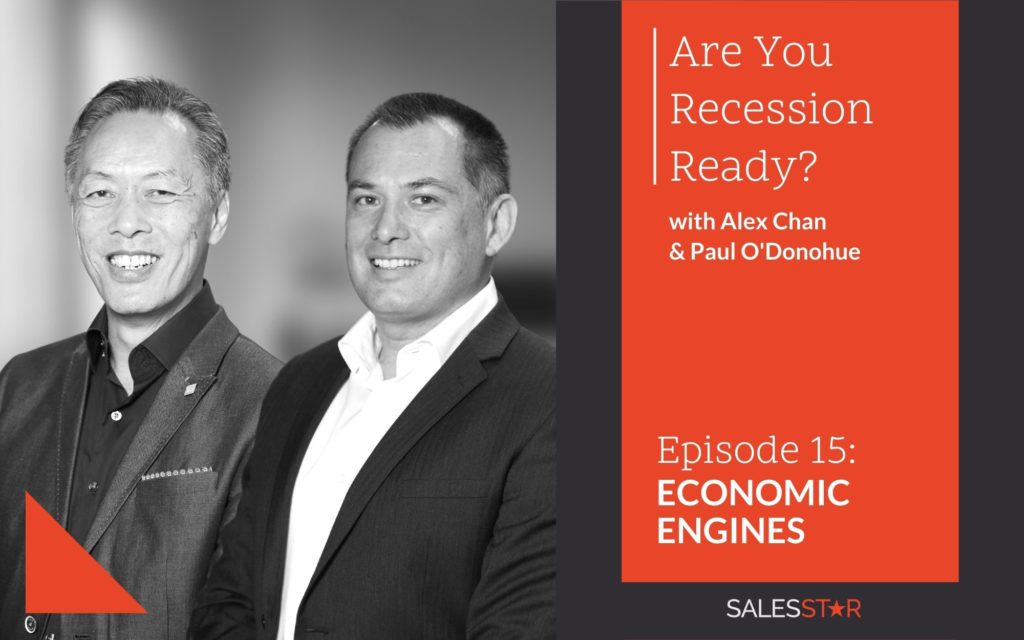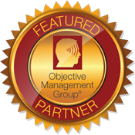Video
Episode Transcript
Alex Chan | Paul O’Donohue
The question we’ve been asking to all business owners and CEOs is, are you Recession Ready? We’ve posed that question throughout this entire series. And I’m hoping that as a result of watching the series, you’re going to say, yes, we are. So in this particular session, we continue our discussion around key strategic plays in order to navigate a tough economic climate, even a recessionary climate. And to help us to have this discussion and to share some insights with us is SalesStar founder and CEO Paul O’Donohue. Paul, I’ve really enjoyed working with you this past 11 years, and one of the great areas where I’ve gotten value out of being your business partner is you are a strategist through and through. We’re talking about key strategic plays. You are a massive one on this particular subject on. Is it time to revise our economic engine? Can you tell us a little bit about what that means?
Well, it’s amazing how much you learn through your mistakes, Alex. And, you know, I think pain is a good teacher because you kind of feel that emotion and then you bank the learnings. And as we go back to the global financial crisis. And then I really had to think about several things through that tough economic climate to really reinvent the way we sold, right? Because what worked previously didn’t work in that tough environment. This is where we had to transition from selling tactically to strategically. But as as we grew, I realized how much the strategies really worked for us. And I wanted to impart that with our clients. So what frustrated me, Alex, at the time, two things in the business was the pain was twofold. One was the strategy wasn’t effective, and we had this lumpy cash flow model. And what I was trying to resolve was, how do we make training sticky, right? The worst thing that I could ever imagine is that we didn’t make a difference to our clients, which is our purpose with we’ve built to make a difference, to grow people, to grow sales. So I tell you this story because we’re talking about economic models and we’re talking about recurring revenue. But it’s the it’s the it’s not the cart before the horse. Right. You’ve got to think about your purpose and your why. So what I’m saying here is my story as to why we changed the model. So the model was to eradicate lumpy cash flow, to bring a recurring revenue model in, which stabilized the business. And that helped us weather the storm through the pandemic massively. A really, really good business model. But second to that, the fundamental reason we were able to have a recurring revenue offer was we wanted to make the training sticky. We actually transformed it from a training company to a sales transformation company in that time. Why? Because we wanted to make a difference. We wanted to know that the training and the coaching we did made a difference. And the only way that we could really force change and make an impact was to embed the learning over time. One off training doesn’t work. It’s a waste of money. So we stop that. We eradicated that out of the business model. What actually worked was consulting, training and high performance coaching over time. So that can be quite a significant investment for a lot of companies. So we also had to make that palatable. So we amortize the cost of that over a 12 month period which enabled us to have a longer relationships with our clients and enabled us to make a significant difference to help grow our clients. And so what we learned in that time, instead of having a client for two days or a couple of months, our clients went well beyond 12 months because we could demonstrate value. Our average client now is spending three years with us. We have long serving clients. Six or seven years. Why? Because we really cared about making a difference first and foremost. And we had a good economic model that could weather the tough conditions through the pandemic.
Okay. So just in summary for our viewers, number one, get your purpose right. And we wanted to make a difference rather than just doing one-off stuff that was a waste of money. That was the first thing. And the second thing was get the economic engine. Right. So on the economic engine, you’re really kind of emulating a SaaS based model. When you have software as a service type of model where there’s just this regular subscription.
Yeah, well it’s a subscription model. Yes. 100% and I tell that story because I believe that every company should be thinking about some sort of recurring revenue subscription. But you need to be thinking about the problem that you’re trying to solve for client, right? Your clients, why would they subscribe to your product or service? What is that problem that you’re trying to solve? So, you know, if you don’t solve that problem and there’s not a real compelling problem that you solving the chances of getting recurring revenue into your business will diminish.
Yeah. Okay. Now, that’s a really good question for the day. You know, regardless of what business I’m in, cannot set up a recurring revenue model. I wonder how they might apply this – our viewers I mean, I saw one particular client, their in major building services and they’ve got new installations, which effectively is construction, and they’ve also got a service department. And one thing the GFC taught them was that they needed to rely heavily on building up their service department because their service contracts were a form of recurring revenue weren’t they and that would have kept them steady during the GFC.
Yeah. Look, if you’re a trade based company, if you’re even selling machines, service contracts, wonderful thing to have recurring revenue, you know, you’ve got to be thinking about that problem again that you’re solving. So does it mean that you have a better service offering, that you’re there within 2 hours of a break down? What does that actually mean? What are the benefits for for your client? So there are I mean, the other thing I can think of over and above service contracts is, you know, the immediate thing I think of is software. Does your product or service have a software element that, you know, is that a critical piece of software to serve your clients? And also, you know, how do you manage that? And can it be can it be built into some sort of subscription?
Okay. So get the purpose right. Ask yourself if you can set up some sort of recurring revenue model and also to go with that. What is the problem that you’re solving, which will, of course, probably drive the market accordingly? Thanks very much for that summary, Paul, of just taking the time to test, to revise our economic engine. I think that’s good advice for our viewers. Thanks for joining us.
You’re welcome.
So to our viewers, does that help? If you were to take a look at revising your economic engine is the old way of doing it necessarily the way that we have to continue. It’s a very important medium and long term strategic play. And if you’d like help in discussing this further, remember, reach out to a SalesStar High-Performance coach because they’re there to help. That brings us series on being Recession Ready to a conclusion. Did you get value out of that? Thanks for joining us. And remember, we’re always here to help you at SalesStar to become a high performance organization.









